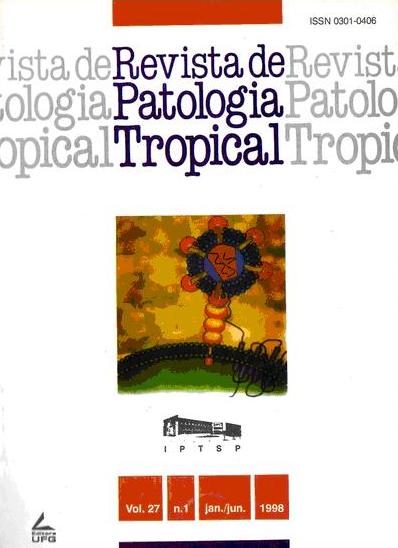PREFERENCIA PARA DIFERENTES TIPOS DE ISCA POR MOSQUITOS (DIPTERA: CULICIDÁE) CAPTURADOS EM GOIÂNIA-GOIÁS
DOI:
https://doi.org/10.5216/rpt.v27i1.17195Abstract
Empregando-se como isca homem, ave (Gallus domesticits), cão (Canis familiaris) esuíno (Scrofa domesticas), obteve-se um total de 9.060 mosquitos em capturas semanais,realizadas na Chácara Naves, em Goiânia, de janeiro a dezembro de 1992. Capturaram-setambém culícideos em abrigos animais (pocilga e galinheiro). Dos 9.060 espécimens, 6.045foram obtidos através de isca humana, 822 em ave, 41 em cão, 27 em suíno, 2.114 em galinheiroe 11 em pocilga. Das 52 espécies registradas, foram capturadas 42 em isca humana, 22 em ave, 8em cão e 7 em suíno. Com relação aos abrigos animais, 10 espécies foram obtidas em galinheiroe 4 em pocilga. Dentre as espécies capturadas 23 concorreram com mais de 0,5% do total obtido.Destacaram-se como antropofílicas Aedes (Ochleroíatus) scapttlaris, Âedes (Ochlerolatus)serratus, Citlex (Culex) dolosus, Haemagogus (Haemagogus) capricornii, Haemagogus(Conopostegus) leucocelaenus, Psorophora (Janthinosoma) ferox e Sabethes (Sabethoides)chloropíenis. Dentre os ornitofílicos salientam-se Aedonyia (Aedonyia) squamipennis, Culex(Culex) dolosus e Culex (Melanoconion) pilosus. Sete espécies sugaram cão, entre elas A.scapularis, A. serralus, Coquilletlidia (Rhynchotaenia) juxíamansonia e C. dolosus. Os suínosatraíram principalmente A. scapularis e coquillettidia {Rhynchotaenia) venezuelensis. Em abrigode ave foram registradas principalmente Á. squamipennis, C. dolosus e C. pilosus. Apenas trêsespécies foram capturadas em pocilga.Downloads
Downloads
How to Cite
Issue
Section
License
The manuscript submission must be accompanied by a letter signed by all authors stating the full name and email address, confirming that the material has not been published or is under consideration for publication elsewhere, and agreeing to transfer copyright in all media and formats for Journal of Tropical Pathology. The authors will not be paid for published articles. They are solely responsible for the content of those articles, even if the Editor holds the right to adjust them to the norms of the journal.
The reviewers will not be paid for the peer review process.

